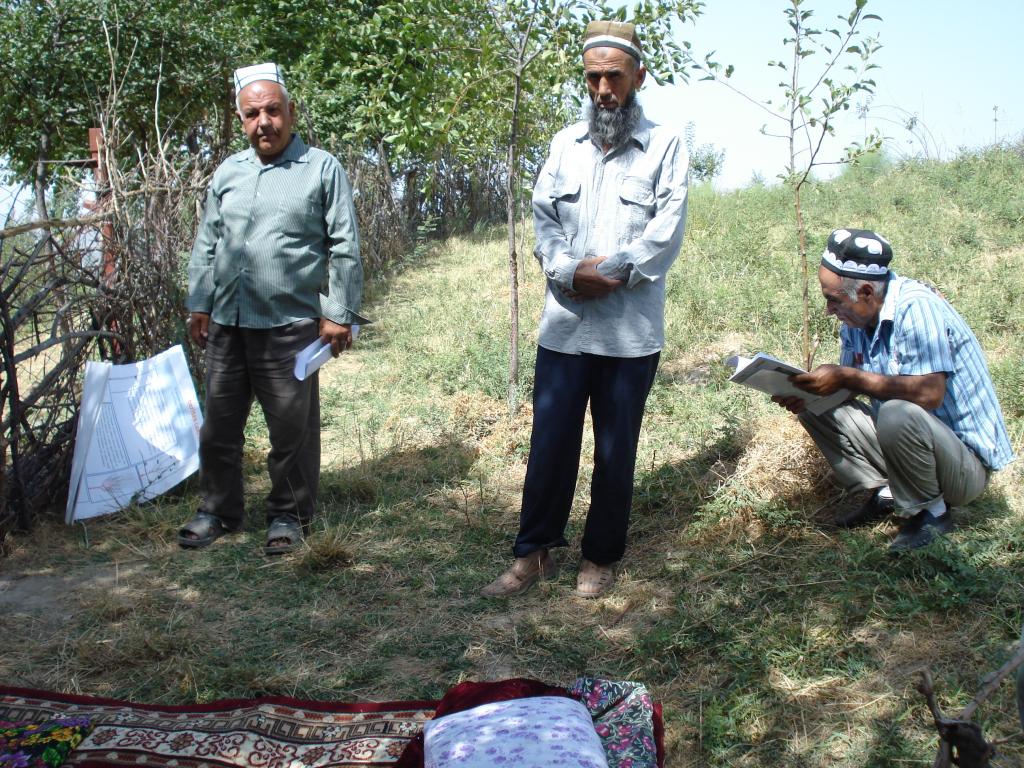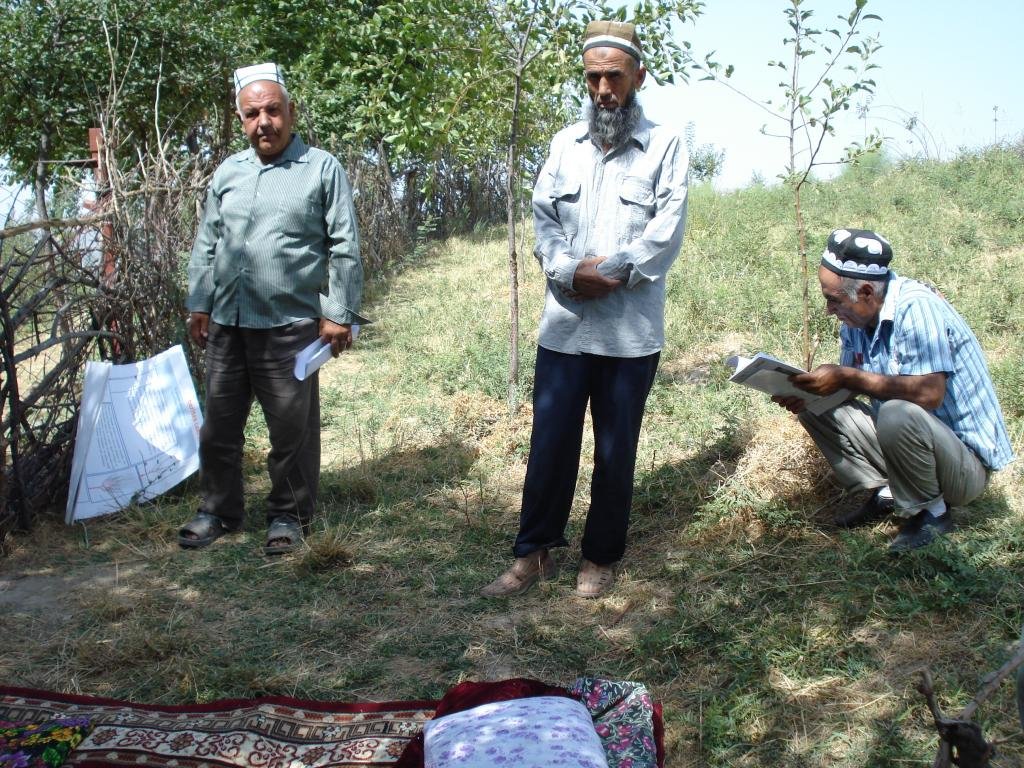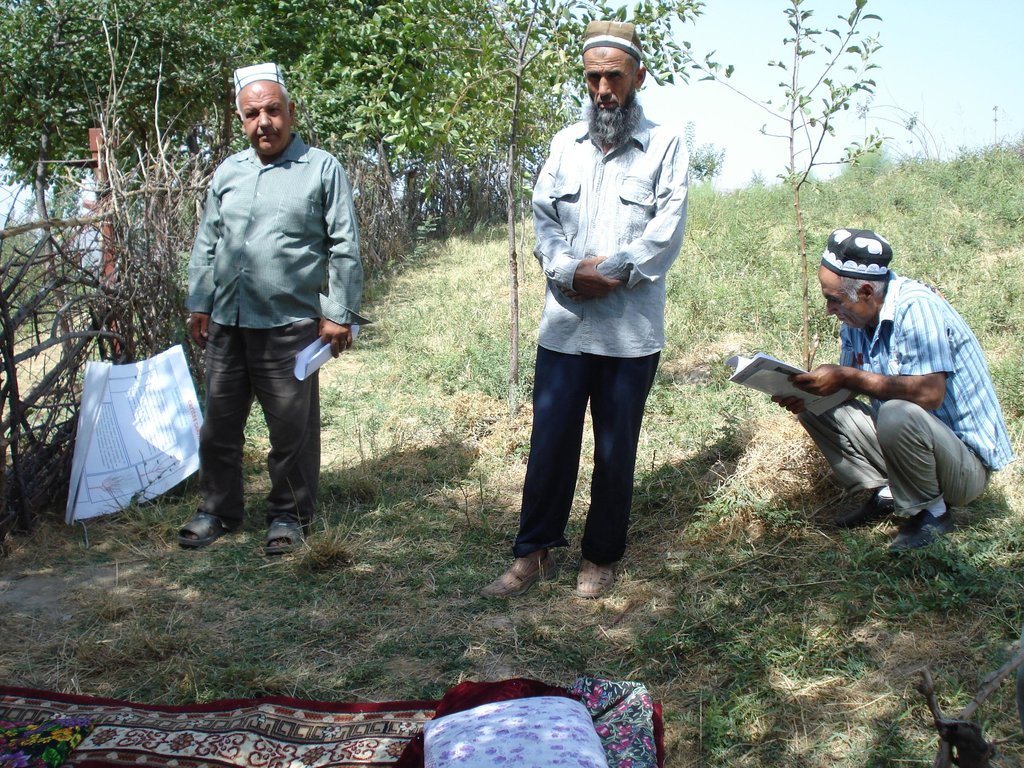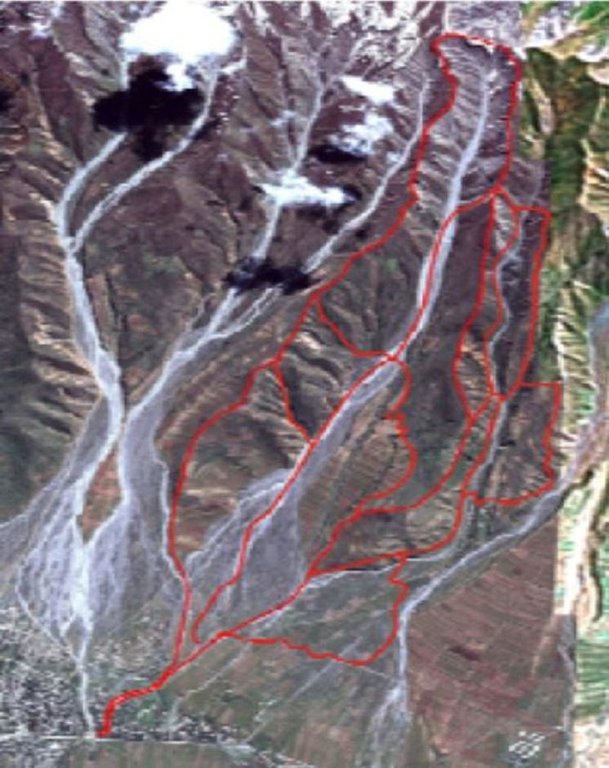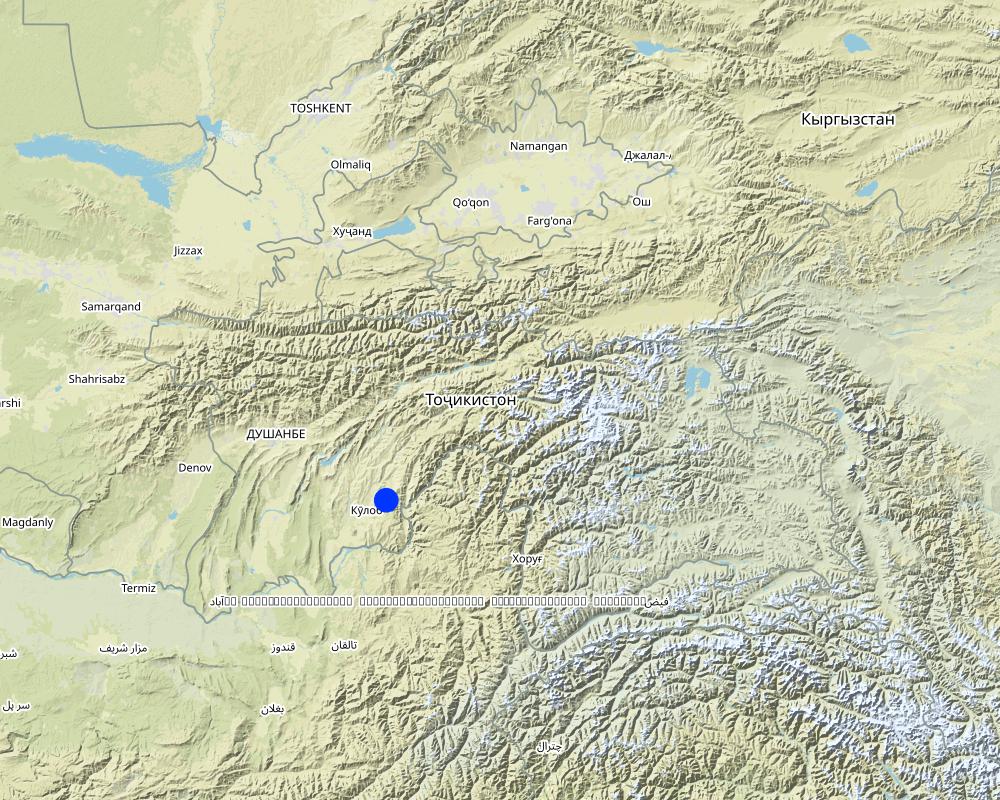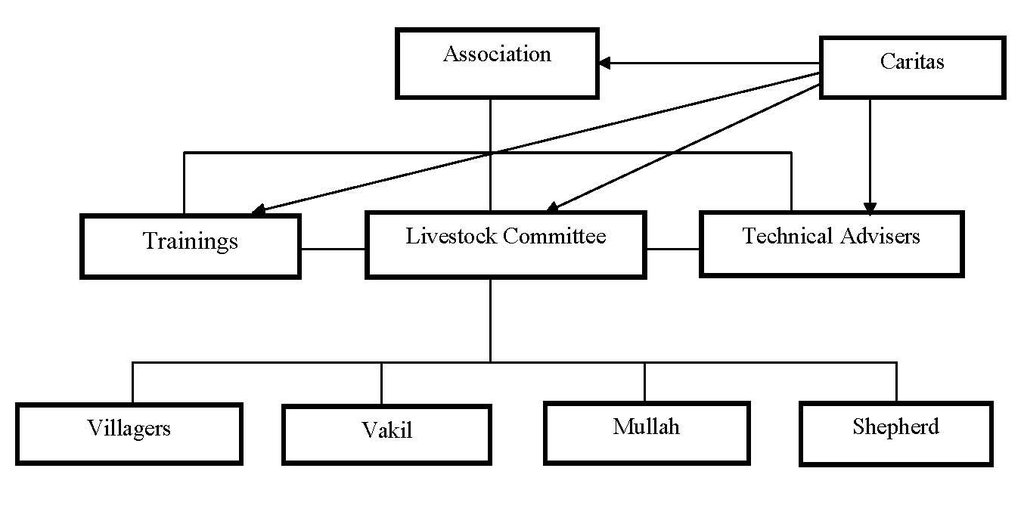Livestock Committee at Village Level [塔吉克斯坦]
- 创建:
- 更新:
- 编制者: Sa'dy Odinashoev
- 编辑者: –
- 审查者: Deborah Niggli, David Streiff, Alexandra Gavilano, Joana Eichenberger
Кумитаи чорврдори дар сатхи деха
approaches_2435 - 塔吉克斯坦
查看章节
全部展开 全部收起1. 一般信息
1.2 参与方法评估和文件编制的资源人员和机构的联系方式
有助于对方法进行记录/评估的项目名称(如相关)
Knowledge Management for Integrated Watershed Management and Disaster Risk Reduction (SDC / IWSM)有助于对方法进行记录/评估的项目名称(如相关)
Pilot Program for Climate Resilience, Tajikistan (WB / PPCR)1.3 关于使用通过WOCAT记录的数据的条件
(现场)数据是什么时候汇编的?:
16/08/2010
编制者和关键资源人员接受有关使用通过WOCAT记录数据的条件。:
是
1.4 SLM技术问卷的参考
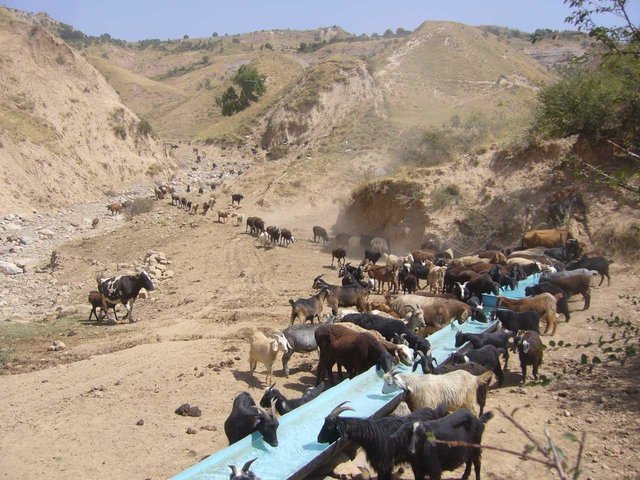
Rotational grazing supported by additional water points [塔吉克斯坦]
After the end of the Soviet era, an increased number of livestock with less grazing land available, has led to the deterioration of the pastures, including overgrazing, reduction of plant diversity, poor livestock health and soil erosion. To tackle the problem, Caritas Switzerland together with livestock committees at village level …
- 编制者: Sa'dy Odinashoev
2. SLM方法的描述
2.1 该方法的简要说明
Livestock committees were established with the goal to improve livestock health as well as natural resource management in the watersheds where the village pastures were situated. Livestock committees in the Muminabad district are organised at village level and coordinate their activities through the registered livestock association at district level.
2.2 该方法的详细说明
该方法的详细说明:
Aims / objectives: This approach applied by Caritas Switzerland, aimed to improve natural resource management in the watersheds through an organised effort of livestock owners. It encourages preventive measures against soil erosion by providing incentives for beneficiaries at community level. The process is managed by the livestock committees, who represent the animal owners at village level. The committees are responsible for organising livestock owners and managing the village pastures by applying rotational grazing principles, establishment of water points and rest places, ensuring safe paths for animals and easy access to pasture lands.
Stages of implementation: The project encompasses the following steps: 1) Competitive call for project proposals to improve livestock and pasture management through villager's efforts, 2) Expression of interest from community members to participate in the competition, 3) Development of project proposals from villagers with assistance of technical staff from the implementing agency (Caritas), 4) Selection and notification of winners, confirmation of village funding commitments, 5) A village general meeting for the inception of project and laying the foundation for the livestock committee, 6) Formalisation of partnership agreement with donor (signed agreements for project implementation), 7) Project implementation transfer into livestock committee’s responsibility, 8) Technical assistance through training and workshops, monitored by the implementing agency (Caritas), 9) Strengthening of the livestock committee as a community based organisation, 10) follow up and continued activity of livestock committee through other projects and self organised activities among livestock owners.
Role of stakeholders: Various locals and village members are essential is assisting with the success of the project; The religious head (mullah) acts as a promoter of idea and mobilises the community through developing villager's interest; the village informal leader (vakil), helps to coordinate the activities; local organisations assist in informing and bringing people together for the meetings. The livestock committee consists of five members, including the appointed head shepherd. This has proven to be an effective size group. The main tasks of this committee include; mapping the pasture lands, organising rotational schemes, informing and training livestock owners of methods to improving pasture grazing, keeping villagers informed, establishing and collecting membership fees, keeping the accounts for the organisation, and application of funds (own or donor’s), develop new ideas and project proposals for further land improvement projects.
Other important information: The villagers are responsible for the labour contribution during the construction of water points or paths/roads. They pay membership fees, which cover the shepherd’s salary and the committee’s activities. They are kept informed of pasture grazing schemes, and control the performance of the committee.
2.3 该方法的照片
2.5 采用该方法的国家/地区/地点
国家:
塔吉克斯坦
区域/州/省:
Khatlon
有关地点的进一步说明:
Muminabad
Map
×2.6 该方法的开始和终止日期
注明开始年份:
2004
终止年份(若不再采用该方法):
2010
2.7 方法的类型
- 基于项目/方案
2.8 该方法的主要目的/目标
The Approach focused mainly on SLM with other activities (Improve the health of livestock to water, safe roads to pasture and rest places)
To implement a responsible body to manage the common pasture land in the village, and improve conditions for livestock husbandry.
The SLM Approach addressed the following problems: Implementation of pasture projects and their sustainability. Little awareness and capacity in the field of sustainable pasture management among villagers, which hampers implementation of pasture projects.
2.9 推动或妨碍实施本办法所适用的技术的条件
社会/文化/宗教规范和价值观
- 阻碍
hierarchical society, individual villagers wait for the religious or governmental leader to make decisions
Treatment through the SLM Approach: Livestock committee to coordinate with the leaders of the society
财务资源和服务的可用性/可得性
- 阻碍
no funds available to pay a herder
Treatment through the SLM Approach: monthly contributions from the villagers
机构设置
- 阻碍
no formal organisation for management of the common pasture land at the village level
Treatment through the SLM Approach: village livestock committees
法律框架(土地使用权、土地和水使用权)
- 启动
The existing land ownership, land use rights / water rights greatly helped the approach implementation: common management of common land by the livestock committee
- 阻碍
unclear situation with regard to water use rights
Treatment through the SLM Approach: village negotiations are facilitated by Caritas Switzerland and the livestock committee
了解SLM,获得技术支持
- 阻碍
limited access to technical knowledge regarding the setup of a water distribution system
Treatment through the SLM Approach: technical advice provided by specialists from Caritas Switzerland
工作量、人力资源可用性
- 阻碍
pasture improvement projects are too large for single people or families
Treatment through the SLM Approach: joint effort of the whole village
3. 相关利益相关者的参与和角色
3.1 该方法涉及的利益相关者及其职责
- 当地土地使用者/当地社区
all community members are involved
everybody can participate, disadvantaged groups have equal access
- SLM专家/农业顾问
international specialists
technical advisors are all male
- NGO
3.2 当地土地使用者/当地社区参与该方法的不同阶段
| 当地土地使用者/当地社区的参与 | 指定参与人员并描述活动 | |
|---|---|---|
| 启动/动机 | 互动 | Projects are elaborated by villagers with support of an international NGO |
| 计划 | 互动 | village meetings, district meetings and proposal presentations |
| 实施 | 外部支持 | Cost sharing is from 80:20 up to 50:50. The village contributes the work force, stones and seedlings. Pipes and knowledge are provided externally. |
| 监测/评估 | 互动 | members of the livestock committee and international NGOs |
| Research | 无 |
3.3 流程图(如可用)
具体说明:
This organisational chart shows how the approach works at village level.
作者:
Sady Odinashoev (Muminabad, Tajikistan)
3.4 有关SLM技术选择的决策
具体说明谁有权决定选择要实施的技术:
- 主要是SLM专家,咨询土地使用者之后
解释:
Decisions on the method of implementing the SLM Technology were made by mainly by SLM specialists with consultation of land users
4. 技术支持、能力建设和知识管理
4.1 能力建设/培训
是否为土地使用者/其他利益相关者提供培训?:
是
明确受训人员:
- 土地使用者
培训形式:
- 农民对农民
- 示范区域
- 公开会议
涵盖的主题:
Training in pasture management, rotational grazing, natural resource management and soil erosion.
4.2 咨询服务
土地使用者有权使用咨询服务吗?:
是
指明是否提供了咨询服务:
- 在土地使用者的土地上
说明/注释:
Key elements: theoretical and practical workshop, monitoring visits
Advisory service is quite adequate to ensure the continuation of land conservation activities; Government and other advisory service are now quite adequate to ensure the continuation of land conservation activities. The government saw the examples of good pasture management and is interested to continue with such approaches in collaboration with the livestock association.
4.3 机构强化(组织发展)
是否通过这种方法建立或加强了机构?:
- 是,非常
具体说明机构的强化或建立程度:
- 本地
具体说明支持类型:
- 能力建设/培训
提供进一步细节:
There were trainings for this Approach
4.4 监测和评估
监测和评估是该方法的一部分吗?:
是
注释:
technical aspects were regular monitored by project staff through observations; indicators: water distribution system
management of Approach aspects were ad hoc monitored by project staff through observations; indicators: participation in committee meetings
pasture rotation aspects were regular monitored by project staff through observations; indicators: daily observations by the shepherd from the livestock committee
There were no changes in the Approach as a result of monitoring and evaluation: None
There were few changes in the Technology as a result of monitoring and evaluation: small changes on the road construction
4.5 研究
研究是该方法的一部分吗?
否
5. 融资和外部物质支持
5.1 该方法中SLM组成部分的年度预算
如果不知道准确的年度预算,请给出一个范围:
- 2,000-10,000
注释(例如主要的资助来源/主要捐助者):
Approach costs were met by the following donors: International (seminars, workshops, meetings): 80.0%; local community / land user(s) (worktime, providing meeting place): 20.0%
5.2 为土地使用者提供财政/物质支援
土地使用者是否获得实施该技术的财政/物质支持?:
是
如果是,请具体说明支持的类型、条件和提供者:
Labour input by land users was rewarded with pipes, maps and technical support
5.3 对特定投入的补贴(包括劳动力)
- 设备
| 具体说明哪些投入得到了补贴 | 程度如何 | 对补贴做出具体说明 |
|---|---|---|
| 工具 | shovel, spades provided by village | |
- 农业
| 具体说明哪些投入得到了补贴 | 程度如何 | 对补贴做出具体说明 |
|---|---|---|
| seedlings | from household gardens | |
- 建筑
| 具体说明哪些投入得到了补贴 | 程度如何 | 对补贴做出具体说明 |
|---|---|---|
| 石料 | collected from field | |
- 基建
| 具体说明哪些投入得到了补贴 | 程度如何 | 对补贴做出具体说明 |
|---|---|---|
| 道路 | 充分融资 | |
| pipes | 充分融资 | |
如果土地使用者的劳动力是一项重要的投入,那么是不是:
- 获得其他物质支持
5.4 信用
是否根据SLM活动的方法给予信用值?:
否
5.5 其它激励或手段
是否有其他激励措施或工具用于促进SLM技术的实施?:
是
如果是,请具体说明:
There were trainings for this Approach for local institutions
6. 影响分析和结论性陈述
6.1 方法的影响
该方法是否帮助土地使用者实施和维护SLM技术?:
- 否
- 是,很少
- 是,中等
- 是,支持力度很大
The soil cover improved, the milk production increased and the cows became fatter and healthier.
该方法是否有助于社会和经济弱势群体?:
- 否
- 是,很少
- 是,中等
- 是,支持力度很大
Everybody is benefitting in the same way.
该方法是否改善了阻碍SLM技术实施的土地使用权/用户权问题?:
- 否
- 是,很少
- 是,中等
- 是,支持力度很大
livestock committee negotiated access to water
Did other land users / projects adopt the Approach?
- 否
- 是,很少
- 是,中等
- 是,支持力度很大
But other organisations and the government have shown interest in these ideas.
Did the Approach lead to improved livelihoods / human well-being?
- 否
- 是,很少
- 是,中等
- 是,支持力度很大
Improvement in pastures, and milk production. Livestock has high importance as it is a large financial investment.
Did the Approach help to alleviate poverty?
- 否
- 是,很少
- 是,中等
- 是,支持力度很大
With this Approach the cows become heavier and produce more milk. These animals then achieve higher prices on the market.
6.2 土地使用者实施SLM的主要动机
- 增加生产
milk, meat
- 增加利润(能力),提高成本效益比
better food, less distance to walk for the animals
- 减少工作量
6.3 方法活动的可持续性
土地使用者能否维持通过该方法实施的措施(无外部支持的情况下)?:
- 是
若是,请说明如何维持:
The committee and collaboration among different stakeholders are well organised and the committee is now working independently. Financial contributions per villager are quite low and villagers are willing to increase them in the future if required.
6.4 该方法的长处/优点
| 土地使用者眼中的长处/优势/机会 |
|---|
| financial contributions of each village household creates ownership (How to sustain/ enhance this strength: Financial contributions per villager are low and can be afforded also by poor households. This assures ongoing contributions.) |
| 编制者或其他关键资源人员认为的长处/优势/机会 |
|---|
| workshops in the villages (How to sustain/ enhance this strength: The livestock committees are integrated in an association and this will assure continued access to information.) |
6.5 该方法的弱点/缺点以及克服它们的方法
| 编制者或其他关键资源人员认为的弱点/缺点/风险 | 如何克服它们? |
|---|---|
| Less participation of the women in the workshops | To explain to the men that women should also attend. |
7. 参考和链接
7.1 方法/信息来源
- 实地考察、实地调查
- 与土地使用者的访谈
链接和模块
全部展开 全部收起链接

Rotational grazing supported by additional water points [塔吉克斯坦]
After the end of the Soviet era, an increased number of livestock with less grazing land available, has led to the deterioration of the pastures, including overgrazing, reduction of plant diversity, poor livestock health and soil erosion. To tackle the problem, Caritas Switzerland together with livestock committees at village level …
- 编制者: Sa'dy Odinashoev
模块
无模块


